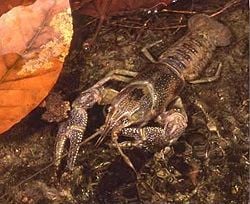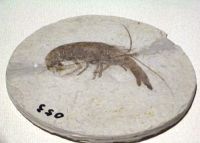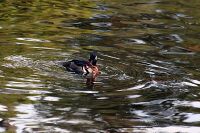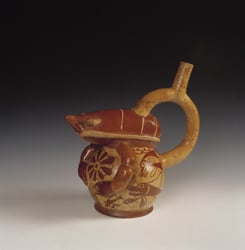Crayfish
| Crayfish | ||||||||||||||||||
|---|---|---|---|---|---|---|---|---|---|---|---|---|---|---|---|---|---|---|
 | ||||||||||||||||||
| Scientific classification | ||||||||||||||||||
| ||||||||||||||||||
|
Astacoidea |
Crayfish, crawfish, crawdads, or crodgers are freshwater crustaceans resembling small lobsters, to which they are closely related. They breathe through feather-like gills and are found in bodies of water that do not freeze to the bottom; they are also mostly found in brooks and streams where there is fresh water running, and which have shelter against predators. Most crayfish cannot tolerate polluted water, although some species such as the invasive Procambarus clarkii are more hardy. Some crayfish have been found living as much as 3 m (10 feet) underground.
In Australia and New Zealand, the name crayfish (or cray) generally refers to a saltwater spiny lobster, of the type Jasus that is indigenous to much of southern Oceania, whilst the freshwater species are usually considered a yabby, or a koura, from the Aboriginal, and Māori, names for the animal respectively.
The study of crayfish is called astacology [1].
Names
The name "crayfish" comes from the Old French word escrevisse (Modern French écrevisse) from Old Frankish *krebitja (cf. crab), from the same root as crawl. The word has been modified to "crayfish" by association with "fish" (folk etymology). The largely American variant "crawfish" is similarly derived.
Some kinds of crayfish are known locally as lobsters, crawdads,[2] mudbugs [2] and yabbies. In the Eastern United States, "crayfish" is more common in the north, while "crawdad" is heard more in central and western regions, and "crawfish" further south, although there are considerable overlaps.[3]
Anatomy
The body of a decapod crustacean, such as a crab, lobster, or prawn, is made up of nineteen body segments grouped into two main body parts, the cephalothorax and the abdomen. Each segment may possess one pair of appendages, although in various groups these may be reduced or missing. On average, crayfish grow to 7.5 centimeters in length, but some grow larger.
Geographical distribution and classification
Template:Commercial crustacean topics
There are three families of crayfish, two in the northern hemisphere and one in the southern hemisphere. The southern-hemisphere (Gondwana-distributed) family Parastacidae lives in South America, Madagascar and Australasia, and is distinguished by the lack of the first pair of pleopods [4]. Of the other two families, members of the Astacidae live in western Eurasia and western North America and members of the family Cambaridae live in eastern Asia and eastern North America.
The greatest diversity of crayfish species is found in south-eastern North America, with over 330 species in nine genera, all in the family Cambaridae. A further genus of astacid crayfish is found in the Pacific Northwest and the headwaters of some rivers east of the Continental Divide.
Australasia is another centre of crayfish diversity, with over 100 species in a dozen genera. Many of the better-known Australian crayfish are of the genus Cherax, and include the marron (Cherax tenuimanus), red-claw crayfish (Cherax quadricarinatus), yabby (Cherax destructor) and western yabby (Cherax preissii). The world's largest crayfish, Astacopsis gouldi, which can achieve a mass in excess of 3 kilograms, is found in the rivers of northern Tasmania.
Madagascar has a single (endemic) crayfish species, Astacopsis madagascarensis.
Europe is home to seven species of crayfish in the genera Astacus and Austropotamobius.
Cambaroides is native to Japan and eastern mainland Asia.
Crayfish as a dish
Crayfish are eaten in Europe, China, Africa, Australia, Canada, and the United States. 98% of the crayfish harvested in the United States come from Louisiana, where the standard culinary terms are crawfish or écrevisses.
Louisiana crawfish are usually boiled live in a large pot with heavy seasoning (salt, cayenne pepper, lemon, garlic, bay leaves, etc.) and other items such as potatoes, maize, onions, garlic, and sausage. They are generally served at a gathering known as a crawfish boil. Other popular dishes in the Cajun and Creole cuisines of Louisiana include crawfish étouffée, crawfish pie, crawfish dressing, crawfish bread, and crawfish beignets [5], and crayfish are an ingredient in Chicken Marengo.
A common myth is that a crawfish with a straight tail died before it was boiled.[6]
Crayfish is a popular dish in Scandinavia, and is by tradition primarily consumed during the fishing season in August. The boil is typically flavoured with salt, sugar, ale, and large quantities of the flowers of the dill plant. The catch of domestic freshwater crayfish, Astacus astacus, and even of a transplanted American species, Pacifastacus leniusculus, is very limited and to satisfy demand the majority of what is consumed has to be imported. Sales depended on imports from Turkey for several decades, but after a decline in supply, China and the United States are today the biggest sources of import.
The Mexican crayfish is named locally as acocil and was a very important nutrition source of the ancient Mexican Aztec culture; now this kind of crayfish is consumed (mainly boiled) and prepared with typically Mexican sauces or condiments in central and southern Mexico.
In China, the culinary popularity of crayfish swept across Mainland China in the late 1990s. Crayfish is generally served with Mala flavour (a combined flavour of Sichuan pepper and hot chili) or otherwise plainly steamed whole, to be eaten with a preferred sauce. In Beijing, the Ma La flavoured crayfish (麻辣小龙虾) is shortened to "Ma Xiao" (麻小) and is often enjoyed with beer in a hot mid-summer evening.
Like other edible crustaceans, only a small portion of the body of a crayfish is edible. In most prepared dishes, such as soups, bisques and étouffées, only the tail portion is served. At crawfish boils or other meals where the entire body of the crayfish is presented, however, other portions may be eaten. Claws of larger boiled specimens are often pulled apart to access the meat inside. Another favourite is to suck the head of the crayfish, as seasoning and flavour can collect in the fat of the boiled interior. A popular double entendre laden phrase heard around crawfish season in Louisiana derives from this practice: "Suck the head, pinch the tail" [7].
Crayfish as pets
Crayfish are kept as pets in freshwater aquariums. They prefer foods like shrimp pellets or various vegetables but will also eat tropical fish food, regular fish food, algae wafers, and even small fish that can be captured by their claws, such as goldfish or minnows. Their disposition towards eating almost anything will also cause them to consume most aquarium plants in a fish tank; however, crayfish are fairly shy and may attempt to hide under leaves or rocks. When keeping a crayfish as a pet, one must provide a hiding space. At night, some fish become less energetic and settle to the bottom. The crayfish might see this as a chance for an easy meal, or a threat, and injure or kill the fish with its claws. Crayfish are effective scavengers and will consume fish carcasses. They sometimes will consume an exoskeleton after it is molted. Since crayfish are accustomed to being around ponds or rivers they will have a tendency to shift gravel around on the bottom of your tank, creating mounds or trenches to emulate a burrow. Crayfish are great escape artists and will try to climb out of the tank, so any holes in the hood should be covered.
However, most species of dwarf crayfish, such as Cambarellus patzcuarensis will not destructively dig or eat live aquarium plants.[8] They are also relatively non-aggressive and can even be kept safely with dwarf shrimp. Because of their very small size of 1.5 inches or less, some fish, such as loaches are often a threat to the crayfish rather than the other way around.
In some nations, such as England, United States, Australia, and New Zealand, imported alien crayfish are a danger to local rivers. The three species commonly imported to Europe from the Americas are Orconectes limosus, Pacifastacus leniusculus and Procambarus clarkii. [9] Crayfish may spread into different bodies of water because specimens captured for pets in one river are often flung back into a different one. There is a potential for ecological damage when crayfish are introduced into nonnative bodies of water.
Crayfish as bait
Crayfish are commonly sold and used as bait, either live or with only the tail meat, and are good at attracting channel catfish, largemouth bass, pike and muskie. However, live crayfish should have the claws removed or they may keep fish from biting the hook. Crayfish also easily fall off of the hook, so casting should be slow.
Crayfish plague
Some crayfish suffer from a disease called crayfish plague. This is caused by the water mould Aphanomyces astaci. Species of the genus Astacus are particularly susceptible to infection, allowing the more resistant signal crayfish to invade parts of Europe. Crayfish plague is not indigenous to Europe, rather it was introduced by the incorporation of new species of crayfish from the Americas. [9]
Other
The Moche people of ancient Peru worshiped animals and often depicted crayfish in their art.[10]
ReferencesISBN links support NWE through referral fees
- ↑ International Association of Astacology.
- ↑ 2.0 2.1 Pableaux Johnson. Mudbug Madness : Crawfish. Bayou Dog. Retrieved 2006-08-28.
- ↑ Bert Vaux & Scott A. Golder. Dialect survey. Harvard University. Retrieved 2006-09-30.
- ↑ Horton H. Hobbs, Jr. (1974). Synopsis of the families and genera of crayfishes (Crustacean: Decapoda). Smithsonian Contributions to Zoology 164: 1–32.
- ↑ Chuck Taggart. The Creole and Cajun Recipe Page. The Gumbo Pages. Retrieved 2007-03-06.
- ↑ Scientist More Interested in Research than Crawfish Boils. Retrieved 2008-02-26.
- ↑ Lessley Anderson. "Do you suck heads? — Easter is crawfish-boil time in Louisiana", Chow.com, 2007-03-27.
- ↑ yoyo, Gerald. Mexican Dwarf Orange Crayfish, Cambarellus patzcuarensis. Retrieved 2008-5-5.
- ↑ 9.0 9.1 Lee, James R. (1998-12-05). TED Case Studies Crayfish Plague #478 European Crayfish Dispute. Retrieved 2008-01-20.
- ↑ Berrin, Katherine & Larco Museum. The Spirit of Ancient Peru:Treasures from the Museo Arqueológico Rafael Larco Herrera. New York: Thames and Hudson, 1997.
Further reading
- Gilbertson, Lance; Zoology Lab Manual; McGraw Hill Companies, New York; ISBN 0-07-237716-X (fourth edition, 1999)
- Johnson, Sterling K. and Nathan K. Johnson. 2008. Texas Crawdads. College Station, Texas. ISBN 978-0-9801103-0-2 available from Crawdad Club Designs
External links
- Louisiana Crawfish Research and Promotion Board
- Crayfish Mates - All Crustacean and Crayfish Forums
- Freshwater aquarium invertebrate, crustacean, crayfish, crabs forum
Credits
New World Encyclopedia writers and editors rewrote and completed the Wikipedia article in accordance with New World Encyclopedia standards. This article abides by terms of the Creative Commons CC-by-sa 3.0 License (CC-by-sa), which may be used and disseminated with proper attribution. Credit is due under the terms of this license that can reference both the New World Encyclopedia contributors and the selfless volunteer contributors of the Wikimedia Foundation. To cite this article click here for a list of acceptable citing formats.The history of earlier contributions by wikipedians is accessible to researchers here:
The history of this article since it was imported to New World Encyclopedia:
Note: Some restrictions may apply to use of individual images which are separately licensed.







